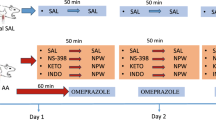Abstract
Platelet-activating factor (PAF) is a potent phospholipid-derived messenger involved in a number of diverse pathological conditions, including mediation of inflammatory cascades associated with wound healing. In this study, we investigated the effect of a specific PAF antagonist, BN52020, on the course of experimentally induced gastric mucosal ulcer healing by analyzing apoptotic processes and the mucosal expression of TNF-α, COX-2, and the activity of inducible nitric oxide synthase (NOS-2). Groups of rats were intragstrically pretreated with BN52020 either 24 and 4 h before acetic acid injury (prophylactic) or 24 and 44 h after the injury (therapeutic) and their mucosal tissue subjected to assessment of ulcer healing rate and biochemical measurements. Compared with the controls, the prophylactic administration of BN52020 produced dose-dependent acceleration in ulcer healing, accompanied by an increase in COX-2 expression and a marked reduction in the extent of mucosal apoptosis, TNF-α and NOS-2 activity. A delay in ulcer healing, however, occurred with BN52020 administered therapeutically, and this effect of the agent was reflected in a decreased COX-2 protein expression and a significant increase in the rate of epithelial cell apoptosis, TNF-α, and the mucosal NOS-2 activity. Thus, PAF antagonist, BN52020, when administered prophylactically exerts anti-inflammatory effects that accelerate gastric ulcer healing, while given therapeutically interferes with COX-2 enzyme expression that leads to a protracted inflammatory responses that delay ulcer healing.
Similar content being viewed by others
REFERENCES
Brinkman, B. M. N., Telliez, J. B., Schievella, A. R., et al. (1999). Engagement of tumor necrosis factor (TNF) receptor 1 leads to ATF-2-and p38 mitogen-activated protein kinase-dependent TNF-α gene expression, J. Biol. Chem. 274, 30882–30886.
Evans, G. and Littlewood, T. (1998). A matter of life and cell death, Science 281, 1317–1322.
Ferraris, L., Karmeli, F., Eliakim, R., et al. (1993). Intestinal epithelial cells contributeto the enhanced generation of platelet activating factor in ulcerative colitis, Gut 34, 665–668.
Gilroy, D. W., Colville-Nash, P. R., Willis, D., et al. (1999). Inducible cyclo-oxygenases may have anti-inflammatory properties, Nature Med. 5, 698–701.
Han, S. J., Ko, H. M., Choi, J. H., et al. (2002). Molecular mechanismsfor lipopolysaccharide-induced biphasic activation of nuclear factor-κB (NF-κB), J. Biol. Chem. 277, 44715–44721.
Hortelano, S., Castrillo, A., Alvarez, A. M., et al. (2000). Contribution of cyclopentenone prostaglandins to the resolution of inflammation through the potentiation of apoptosis in activated macrophages, J. Immunol. 165, 6525–6531.
Im, S. Y., Han, S. J., Ko, H. M., et al. (1997). Involvement of nuclear factor-·B in platelet-activating factor-mediated tumor necrosis factor-α expression, Eur. J. Immunol. 27, 2800–2804.
Karin, M. and Ben-Neriah, Y. (2000). Phosphorylation meets ubiquitination: the control of NF-κB activity, Annu. Rev. Immunol. 18, 621–663.
Kitajima, T., Yamaguchi, T., Tani, K., et al. (1993). Role of endothelin and platelet-activating factor in indomethacin-inducedgastric mucosal injury in rats, Digestion 54, 156–159.
Kravchenko, V. V., Pan, Z., Han, J., et al. (1995). Platelet-activatingfactor induces NF-κB activation through a G protein-coupled pathway, J. Biol. Chem. 270, 14928–14934.
Lawrence, T., Gilroy, D. W., Colville-Nash, P. R., et al. (2001). Possible new role for NF-κB in the resolution of infl ammation, Nature Med. 7, 1291–1297.
Liu, S. F., Ye, X. and Malik, A. B. (1999). Inhibitionof NF-κB activationby pyrrolidinethiocarbamate prevents in vivo expression of proinfl ammatory genes, Circulation 100, 1330–1337.
Madrid, L. V., Mayo, M. W., Reuther, J. Y., et al. (2001). Akt stimulates the transactivation potential of the RelA/ p65 subunit and of NF-kB through utilization of the IkB kinase and activation of the mitogen-activated protein kinase p38, J. Biol. Chem. 276, 18934–18940.
Poligone, B. and Baldwin, A. S. (2001). Positive and negative regulation of NFκB by COX-2, J. Biol. Chem. 276, 38658–38664.
Rossi, A., Kapahi, P., Natoli, G., et al. (2000). Anti-inflammatory cyclopentenone prostaglandins are direct inhibitors of IκB kinase, Nature 403, 103–108.
Shigeta, J., Takahashi, S. and Okabe, S. (1998). Role of cyclooxygenase-2 in the healing of gastric ulcers in rats, J. Pharmacol. Exp. Ther. 286, 1383–1390.
Shukla, S. D. (1992). Platelet-activatingfactor receptor and signal transductionmechanisms, FASEB J. 6, 2296–2302.
Slomiany, B. L., Piotrowski, J. and Slomiany, A. (1996). Synchronized induction in bFGF and Cdk2 during gastric ulcer healing, Biochem. Mol. Biol. Int. 40, 339–356.
Slomiany, B. L., Piotrowski, J. and Slomiany, A. (1998). Role of basic fi broblast growth factor in the suppressionof apoptotic caspase-3 during chronic gastric ulcer healing, J. Physiol. Pharmacol. 49, 489–500.
Slomiany, B. L., Piotrowski, J. and Slomiany, A. (1999). Downregulation of endothelin-1 by inter-leukin-4 during gastric ulcer healing, Biochem. Biophys. Res. Commun. 263, 591–595.
Slomiany, B. L. and Slomiany, A. (2001). Role of ERK and p38 mitogen-activated protein kinase cascades in gastric mucosal inflammatory responses to H. pylori lipopolysaccharide, IUBMB Life 51, 315–320.
Slomiany, B. L. and Slomiany, A. (2002). Role of peroxisome proliferator-activated receptor γ activation in gastric mucosal ulcer healing, Inflammopharmacology 9, 347–359.
Tak, P. P. and Firestein, G. S. (2001). NF-κB: a key role in inflammatory diseases, J. Clin. Invest. 107, 7–11.
Vincent, J. L., Sapapen, H., Bakker, J., et al. (2000). Phase II multicenter clinical study of the platelet-activatingfactor receptor antagonist BB-882 in the treatment of sepsis, Crit. Care Med. 28, 638–642.
Wallace, J. L., Hogaboam, C. M. and McKnight, G. W. (1990). Platelet-activating factor mediates gastric damage induced by hemorrhagic shock, Am. J. Physiol. 259, G140–G146.
Wallace, J. L. and Ma, L. (2001). Inflammatory mediators in gastrointestinal defense and injury, Exp. Biol. Med. 226, 1003–1015.
Yamamoto, A. J. and Gaynor, R. B. (2001). Therapeutic potential of inhibition of the NF-κB pathway in the treatment of inflammation and cancer, J. Clin. Invest. 107, 135–142.
Author information
Authors and Affiliations
Rights and permissions
About this article
Cite this article
Slomiany, B.L., Slomiany, A. Differential role of platelet-activating factor in gastric mucosal ulcer healing. Inflammopharmacology 11, 237–248 (2003). https://doi.org/10.1163/156856003322315587
Issue Date:
DOI: https://doi.org/10.1163/156856003322315587




